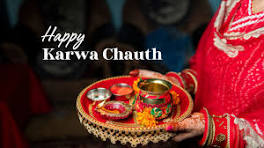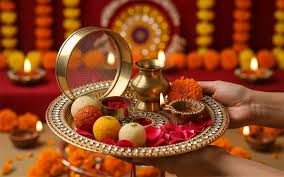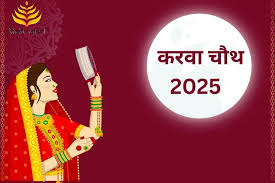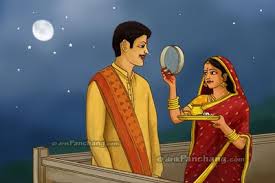
Karva Chauth: A Celebration of Love, Devotion, and Togetherness
Karva Chauth is one of the most significant festivals celebrated by married women in India. Observed primarily in states like Punjab, Haryana, Delhi, Uttar Pradesh, and Rajasthan, this festival reflects love, commitment, and the sacred bond of marriage. On this day, women fast from sunrise to moonrise for the long life, health, and prosperity of their husbands. With time, the festival has not only remained a spiritual ritual but has also evolved into a symbol of love and togetherness in modern households.

The Significance of Karva Chauth
The term “Karva” refers to an earthen pot used to store water, while “Chauth” means the fourth day, as the festival falls on the fourth day of the Hindu month of Kartik (October–November). The pot signifies prosperity and well-being, while the day itself carries a deep spiritual meaning of devotion, sacrifice, and blessings.
At its core, Karva Chauth is about strengthening the marital bond. By observing this fast, women express gratitude for their partners and pray for their safety and longevity. In many families, it is also believed that fasting on this day enhances love, trust, and harmony in married life.

Mythological Stories Behind Karva Chauth
Several stories and legends are associated with Karva Chauth, each adding cultural richness to the festival:
- The Story of Queen Veervati – According to legend, Queen Veervati was a devoted wife who observed her first Karva Chauth fast. However, unable to bear hunger, her brothers tricked her into breaking the fast before moonrise. As a result, tragedy struck her husband. Heartbroken, she prayed sincerely, and the gods blessed her with her husband’s revival. Since then, women observe Karva Chauth strictly until moonrise.
- The Legend of Karva – Another tale speaks of a devoted woman named Karva. When her husband was caught by a crocodile, Karva prayed to Yama, the god of death, to spare his life. Moved by her devotion, Yama granted her wish. This story highlights the power of loyalty, love, and a wife’s prayers.
- Draupadi and the Mahabharata Connection – It is also believed that Draupadi observed a similar fast for the well-being of Arjuna during the time of the Mahabharata.
These stories not only bring depth to the tradition but also emphasize the values of love, sacrifice, and unwavering faith.
Rituals and Traditions of Karva Chauth
Karva Chauth rituals begin before sunrise and continue until moonrise. Each step has cultural and spiritual importance:

- Sargi – The day begins with a pre-dawn meal known as Sargi, prepared by mothers-in-law for their daughters-in-law. It typically includes fruits, sweets, parathas, and dry fruits. Eating this helps women stay energized throughout the day while fasting.
- Fasting – Women abstain from food and water until they see the moon. The fast is a true test of willpower and devotion.
- Karva Puja – In the evening, married women gather in groups dressed in traditional attire, usually red or bright-colored sarees and lehengas. They apply mehendi, wear jewelry, and carry decorated thalis. The puja involves passing around the Karva (clay pot) and listening to the Karva Chauth story from an elder woman.
- Moonrise Rituals – Once the moon rises, women look at the moon through a sieve, then view their husbands through the same sieve. They offer prayers and water to the moon, and the husband helps his wife break her fast by offering her water and sweets.
This ritual symbolizes mutual love and support between husband and wife.
Karva Chauth in Modern Times
While the essence of Karva Chauth remains traditional, its celebration has evolved with modern lifestyles. Today, the festival is not limited to women alone. Many men also choose to fast alongside their wives as a gesture of equality and mutual respect. Social media platforms are filled with pictures of couples celebrating together, making it not only a cultural tradition but also a romantic celebration.
Jewelry brands, fashion houses, and beauty parlors also prepare for Karva Chauth with special offers, as women shop for new sarees, bangles, and mehendi designs. Urban families celebrate with a blend of tradition and modernity, turning the day into an occasion of joy, festivity, and bonding.
The Emotional and Spiritual Aspect
Beyond rituals, Karva Chauth carries a deep emotional significance. Fasting is not just about skipping food; it is about practicing discipline, expressing love selflessly, and reinforcing the sacred vows of marriage. For many, the festival becomes a day of gratitude—thanking the universe for their loved ones and wishing for lifelong companionship.
It also fosters family bonding. The preparation of sargi, gifting, and gathering for the evening rituals allow families to come together, celebrate, and strengthen relationships.
Tips to Observe Karva Chauth Smoothly
- Stay Hydrated Before Sunrise – Drink enough water and include hydrating foods in your sargi meal like fruits and yogurt.
- Choose Nutritious Foods – Eat balanced foods rich in protein, fiber, and healthy fats to stay energetic.
- Engage in Light Activities – Avoid overexertion and keep yourself busy with light tasks to ease fasting.
- Focus on Positivity – Spend the day with gratitude, prayer, and love rather than stressing over hunger.
- Break the Fast Gently – After moonrise, start with water and fruits before eating a full meal.
Conclusion
Karva Chauth is more than just a ritual; it is a heartfelt expression of love, sacrifice, and marital devotion. While the customs have evolved over the years, the essence remains the same—praying for the happiness and well-being of one’s partner. It beautifully combines tradition with emotion, making it one of the most cherished festivals for married couples in India.
Whether celebrated in a traditional way in villages or with a modern touch in cities, Karva Chauth continues to symbolize timeless love and togetherness.

Karva Chauth FAQ
1. What is Karva Chauth?
Karva Chauth is a traditional Hindu festival celebrated by married women, where they fast from sunrise to moonrise for the long life, health, and prosperity of their husbands. It is observed mainly in North Indian states like Punjab, Haryana, Delhi, and Rajasthan.
2. When is Karva Chauth celebrated in 2025?
Karva Chauth is observed on the fourth day after the full moon in the Hindu month of Kartik. In 2025, it will be celebrated on [insert exact date].
3. What is the significance of Karva Chauth?
The festival symbolizes love, devotion, and the sacred bond of marriage. Women pray for their husbands’ well-being, prosperity, and long life. It also emphasizes family bonding and gratitude in married life.
4. What are the key rituals of Karva Chauth?
- Sargi: Pre-dawn meal given by mothers-in-law.
- Fasting: Women abstain from food and water until moonrise.
- Karva Puja: Evening prayers with decorated thalis and listening to Karva Chauth stories.
- Moonrise Ritual: Women break their fast after seeing the moon and their husbands through a sieve.
5. Can men observe Karva Chauth too?
Yes! Many modern couples choose to celebrate together. Men sometimes fast alongside their wives as a gesture of love, equality, and mutual respect.
6. What are some tips to observe Karva Chauth smoothly?
- Eat a nutritious sargi meal before sunrise.
- Stay hydrated and consume energy-rich foods.
- Avoid heavy physical work during the day.
- Focus on positivity and devotion rather than hunger.
7. Is Karva Chauth only for married women?
Traditionally, yes. However, some unmarried women also observe it for finding a good life partner or for family blessings.
8. What is the story behind Karva Chauth?
There are several legends, including the tales of Queen Veervati and Karva, which highlight devotion, love, and the power of a wife’s prayers to protect her husband.
9. What should be worn on Karva Chauth?
Women typically wear traditional attire like sarees or lehengas in red or bright colors. Jewelry, mehendi, and bangles are also an important part of the celebration.
For the Latest Jobs Notifications: Click Here
Join With Us On WhatsApp: Click Here
Join With Us On LinkedIn: Click Here
Free Python Learning: Click Here